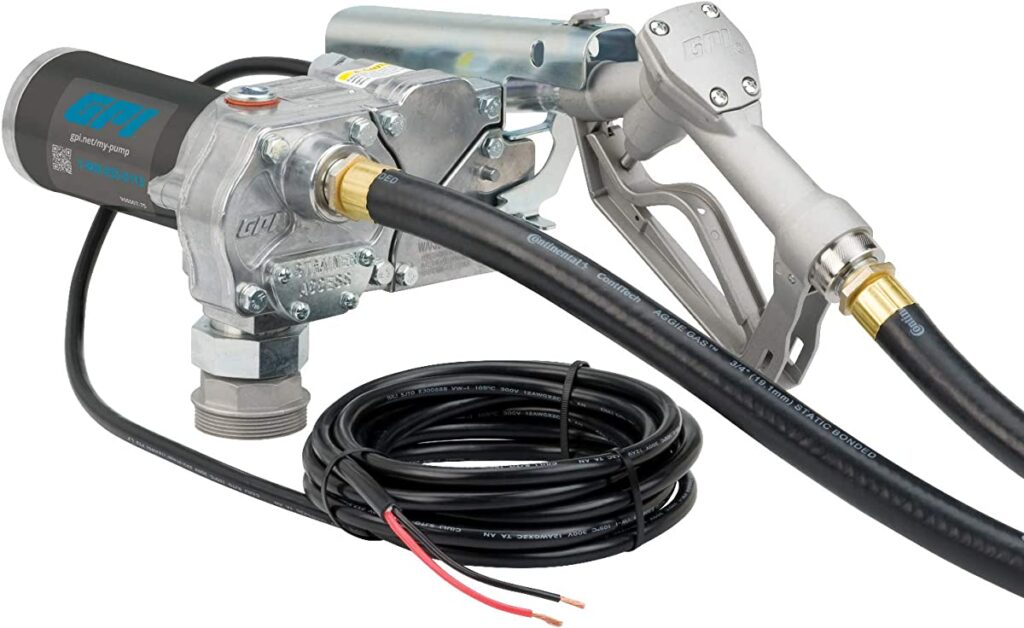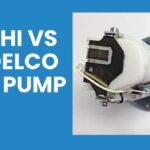GPI offers a full line of fuel transfer pumps, offering a variety of flow rates, materials, and power sources. Their pumps have been long trusted by businesses, from large enterprise fuel tankers to small automotive shops.
GPI fuel transfer pumps provide reliable solutions for your fluid-transferring needs. With innovative features and benefits that make GPI a leading provider in pumping technology, you can trust our product to support all of your applications – from farmers searching for optimum productivity, to experienced gardeners desiring top-notch components.
Discover why customers keep coming back to us: stay tuned as we explain the key elements behind this exceptional brand.
GPI has been manufacturing pumps for over 25 years, and its products are known for their quality and durability. In this article, we’ll take a closer look at the GPI fuel transfer pump line-up, and we’ll discuss the pros and cons of each one. We’ll also provide some tips on choosing the right pump for your needs.
| Pros | Cons |
| The pump is easy to install and use. It is compact and lightweight, making it easy to transport. It is durable and can withstand harsh conditions. It is reliable and has a long life span. | The instructions can be difficult to understand, which can lead to confusion when trying to use the pump. The pump is also able to handle a wide range of fuel types, making it versatile and useful for many applications. |
GPI Fuel Transfer Pump Reviews

GP I fuel transfer pumps are a popular choice for transferring fuel from one tank to another. They’re easy to install and use, and they come with a range of features that make them ideal for a variety of applications.
- Automatic shut-off when the target level is reached
- Thermal overload protection for added safety
- Low noise levels for discrete operation
- Corrosion-resistant materials for extended life
GPI has a wide range of fuel transfer pumps to choose from, so you’re sure to find the perfect pump for your needs. Whether you need a small portable pump or a large industrial pump, GPI has you covered. Plus, their pumps are backed by a comprehensive warranty, so you can be sure your investment is protected.
Customer Reviews and Ratings
Robbinson had been searching for a reliable fuel transfer pump to help him manage his business’s fuel needs. He had heard great things about GPI brand pumps, and decided that they would be the perfect choice for his needs. After researching several different models of GPI pumps, he finally settled on the model with the highest customer ratings – one that was both reliable and affordable.
The moment he received his new pump in the mail, John was eager to get it installed so he could start transferring fuel for his business operations. He read through all of the installation instructions carefully before beginning assembly, taking extra precaution not to miss any steps or make any mistakes during setup. Once everything was connected properly, Robbinson tested out the pump by running some fuel through it from an auxiliary tank nearby – one that wasn’t part of his regular operations yet. To his delight, everything worked perfectly!
From this point forward, Robbinson has been able to rely on GPI’s highly-rated fuel transfer pumps whenever he needs them most; helping him move large quantities of liquid between tanks quickly and easily without ever having to worry about reliability issues or breakdowns like other cheaper brands might have caused in years past. His customers are happy because their deliveries now arrive faster than ever before – and no matter how much volume they need moved at once – Robbinson can always trust in GPI’s quality products each and every time.
GPI customers are overwhelmingly satisfied with their transfer pump, consistently rating it highly for its reliable and efficient performance. Delivering on its promise of optimized fuel transfers and convenience, GPI’s Fuel Transfer Pump is a customer favorite.
Cost Comparison of GPI Fuel Transfer Pump
GPIFuel offers the most cost-effective fuel transfer pumps on the market. For example, our T1000 fuel transfer pump costs just $299 USD, while our T2000 fuel transfer pump costs only $399 USD. Both models are top quality and offer superior performance.
In addition to our low prices, GPIFuel also offers unbeatable customer service. We are always here to help you with whatever you need, and we guarantee that you will be satisfied with your purchase. So don’t wait any longer.
What is a fuel transfer pump and what are its uses?
A fuel transfer pump is a device used to move fuel from one storage container to another. There are many different types of fuel transfer pumps, but they all share the same basic function.
Fuel transfer pumps are commonly used in industrial and commercial settings, where large quantities of fuel need to be moved around quickly and efficiently. They can also be used in residential settings for transferring gasoline or diesel from a tank to a car or truck.Fuel transfer pumps are an essential piece of equipment for anyone who needs to move fuel around regularly. They are reliable, efficient, and easy to use, and they can save you a lot of time and hassle.
How to choose the right fuel transfer pump for your needs?
There are a few things you need to take into account when choosing a fuel transfer pump:
- The type of fuel you’ll be transferring (gasoline, diesel, kerosene, etc.)
- The maximum flow rate you’ll need
- The maximum pressure you’ll need
- The size and shape of the pump head
Once you know what type of fuel you’ll be transferring and what your flow and pressure requirements are, you can begin to look at specific pumps that meet those needs. It’s important to make sure the pump is compatible with the hoses and fittings you’re using, as well as the tank or container you’ll be transferring the fuel into.
How to install a GPI fuel transfer pump?
Installing a GPI fuel transfer pump is a fairly straightforward process. Here are the steps you’ll need to take:
- Shut off the fuel supply to the tank you’re transferring fuel from.
- Open the valve on the tank being emptied and allow it to drain completely.
- Disconnect any hoses or tubing attached to the tank’s outlet port.
- Connect the inlet port of the pump to the outlet port of the tank being emptied.
- Reconnect any hoses or tubing attached to the pump’s inlet port.
- Turn on the fuel supply to the tank you’re transferring fuel from and start up the pump.
The benefits of using a GPI fuel transfer pump
There are a number of benefits to using a GPI fuel transfer pump. Some of the key benefits include:
- Eliminates the need for priming
- Prevents fuel starvation and dry starts
- Minimizes wear and tear on engine components
- Efficient and reliable fuel transfer
If you’re looking for an efficient, reliable, and durable fuel transfer pump, then a GPI fuel transfer pump is a perfect choice. With over 30 years of experience in the industry, GPI has the expertise to provide you with a pump that meets your specific needs.
FAQ
What happens if the pump pressure is too high?
Excessively high water pressure can be a major hazard, resulting in pipes bursting and the potential for damage to property or even risk of injury. To ensure safety, regularly inspect your pump’s control setting as well as it switch/wiring setup; additionally verify that any associated tanks have an effective pressure relief valve installed.
How do I know if my pump is strong enough?
Take control of your comfort level with the Maximum Comfort Vacuum. Adjust the vacuum until you receive a pleasant sensation, then reduce it slightly to ensure maximum relaxation.
How do I troubleshoot a GPI fuel transfer pump?
If you’re experiencing problems with your GPI fuel transfer pump, here are a few troubleshooting tips that may help:
- Make sure the pump is properly plugged into an electrical outlet and that it’s turned on.
- Check the hoses and connectors for leaks or damage.
- Make sure the fuel tank is properly vented.
- Try cleaning the filter screen on the pump head.
- If the pump still isn’t working, try replacing the diaphragm assembly or the entire pump head.
How do I maintain a GPI fuel transfer pump?
The GPI fuel transfer pump is a vital piece of equipment for any vessel. It is responsible for transferring fuel from the tanks to the engines, allowing the vessel to move through the water. Proper maintenance of the GPI fuel transfer pump is essential to ensure that it continues to function properly. Here are a few tips on how to maintain your GPI fuel transfer pump:
- Keep the pump clean and free of debris.
- Check seals and gaskets for damage or wear.
- Inspect hoses for cracks or leaks.
- Make sure all fasteners are tightened securely.
- Replace any worn or damaged parts as needed.
- Clean out the filter periodically (depending
What are the most common problems with GPI fuel transfer pumps?
The most common problems with GPI fuel transfer pumps are leaks, air entrainment, and incorrect installation.Leaks can occur if the pump seals are not properly seated or if the gaskets are damaged. Air entrainment can cause cavitation and reduced pump performance. Incorrect installation can result in damage to the pump or the piping system.
Final Words
Finally, if you’re looking for a fuel transfer pump that’s both efficient and durable, the GPI Fuel Transfer Pump is a great option. It features a brass body and Viton seals that can withstand high temperatures and harsh chemicals, making it ideal for use with gasoline, diesel fuel, kerosene, and other fuels. There is also another pump that provides the lowest cost than this pump called: the Herko fuel pump.







